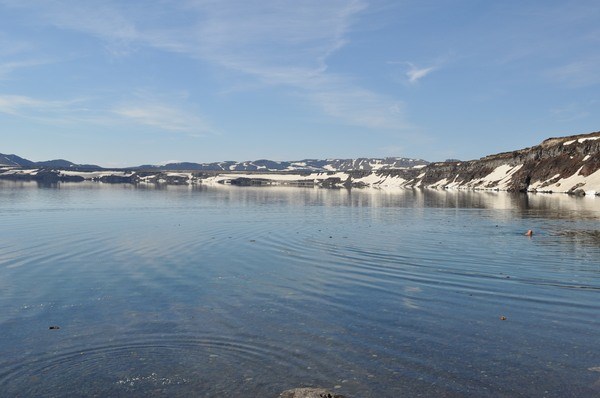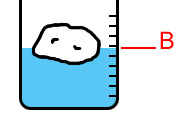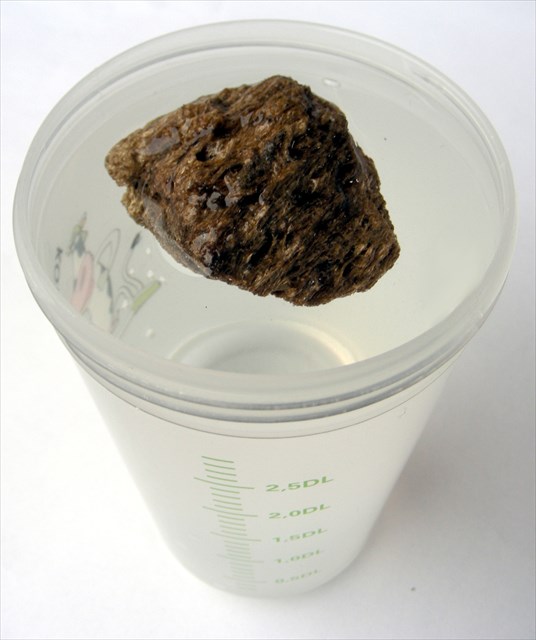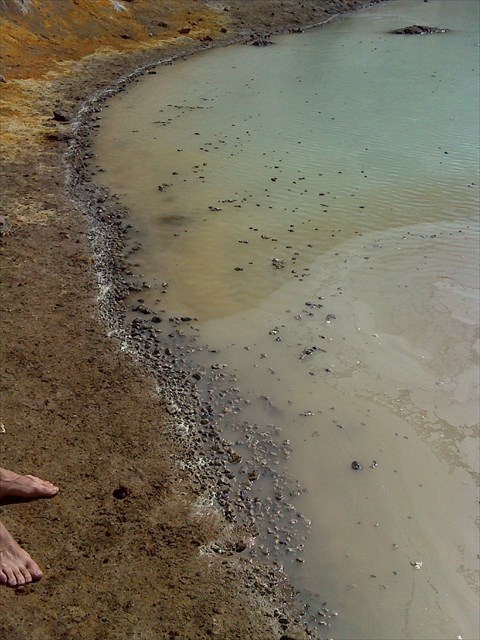Floating Rocks at Askja EarthCache
-
Difficulty:
-

-
Terrain:
-

Size:  (other)
(other)
Please note Use of geocaching.com services is subject to the terms and conditions
in our disclaimer.
Askja
Askja is a stratovolcano situated in a remote part of the central highlands of Iceland. Öskjuvatn is a large lake that fills much of the smaller caldera resulting from the 1875 eruption. Öskjuvatn is the second deepest lake in Iceland at 220 m deep. Víti is a smaller explosion crater on the north east shore of Öskjuvatn, approximately 150 metres diameter. It contains a geothermal lake of mineral-rich, sulphurous, opaque blue water, which has a comfortable temperature for swimming.
 |
 |
| Lake Öskjuvatn |
Floating pebble at Öskjuvatn |
Rocks that float
Pumice is a volcanic rock that consists of highly vesicular rough textured volcanic glass. It is created when super-heated, highly pressurized rock is violently ejected from a volcano. The unusual foamy configuration of pumice happens because of simultaneous rapid cooling and rapid depressurization. The depressurization creates bubbles by lowering the solubility of gases (including water and CO2) that are dissolved in the lava. This cause the gases to rapidly exsolve (like the bubbles of CO2 that appear when a carbonated drink is opened). The simultaneous cooling and depressurization freezes the bubbles in the matrix.
Pumice is commonly pale in color, ranging from white, cream, blue or grey, to green-brown or black. Pumice has an average porosity of 90%, and may float on water as long as the rock it not filled with water. In 1979, 1984 and 2006, underwater volcanic eruptions near Tonga created large pumice rafts, some as large as 30 km that floated hundreds of kilometres to Fiji. (Source: Wikipeadia).
The Askja area is rich in pumice. Scientists estimate that 75% of the total ejecta of the 1875 eruption was pumice. (Source: Sparks, Wilson and Sigurdsson: The Pyroclastic Deposits of the 1875 Eruption of Askja, Iceland).
Your task:
- Find some rocks that can float: You do not need to go to the exact coordinates. Any place at the shore of Öskjuvatn or Víti is fine, but you probably find the best selection at Öskjuvatn. Test the rocks in the lake. Take a close look at the sort of pumice found here at Askja, and send me a few lines with your own description: What is the colour? Are the rock surface smooth or sharp? Matte or glossy? Could any of the rock above be found here?
- Find a handy size piece of pumice and perform the experiment below to measure the density. If you bring a measuring jug, you can perform it at the shore.
- Optional: Take a picture of your GPS at either shore and post it with your "Found it" log. You may also be in the photo.
 “Weightlifting” large pumice rock is also a good photo motive.
“Weightlifting” large pumice rock is also a good photo motive.
- Send your value for A, B, C, D, E and F to my profile at geocaching.com. You need not wait for my answer to log your find. I will contact you if there is a problem with your answers.
How to measure the density:
|
1. Fill the measuring jug with water to about half, but preferably up to a marking. Note down the water level in the jug (in mL) - this is amount A.
|
 |
|
2. Float the piece of pumice rock in the jug and note down the new water level (in mL) - this is amount B. Because the pumice is now floating, the difference between A and B gives you the amount of water displaced by the pumice and therefore, knowing that the density of water is 1kg/L, the mass of the pumice.
|
 |
|
3. Subtract A from B and this gives amount C which is both the volume of water displaced, in milli-litres (mL), and the mass (in grams) of the pumice sample.
|
 |
|
4. Next, use your finger to completely submerge the pumice rock in the water in the measuring jug. Be careful to only just submerge it - don't push it so far into the water that your finger is also in the water. Note down the new water level (in mL) - this is amount D. This allows you to calculate the total volume of the pumice sample and further allows you to calculate the density.
|
 |
|
5. So subtract A from D and this gives amount E which is the total volume of water displaced, in millilitres (mL) by fully submerging the pumice stone, equalling the volume of the pumice rock itself. Since density is calculated as mass divided by volume, divide value C by value E to give F which is the density of the pumice rock, in kg/L.
|
 |
(Measurment figures are used with the kind permission of funkymunkyzone).
You have to have been at the location after the release date of this cache - old holiday visits do not count and are not accepted.
 |
 |
|
Floating pebbles at Víti |
Additional Hints
(No hints available.)